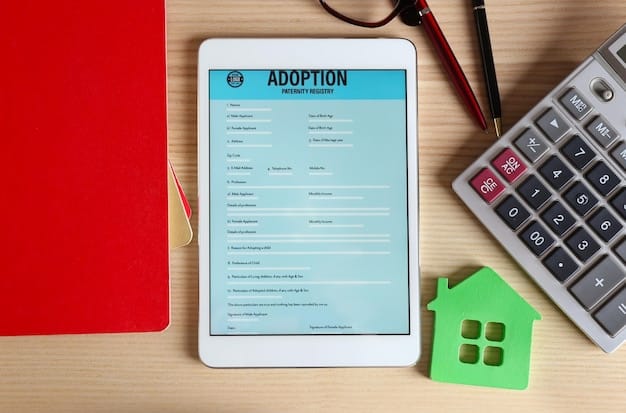FAFSA in 2025: Your Step-by-Step Guide for Students & Parents

Anúncios
The Free Application for Federal Student Aid (FAFSA) is undergoing significant changes in 2025, making it crucial for students and parents to understand the updated process to maximize their eligibility for financial aid, scholarships, and grants.
Navigating the **FAFSA in 2025: A Step-by-Step Guide for Students and Parents** can seem daunting, but with the right information, it can be a straightforward process, opening doors to valuable financial aid for college.
Anúncios
Understanding the FAFSA Changes in 2025
The FAFSA, or Free Application for Federal Student Aid, is a cornerstone of financial aid for students pursuing higher education in the United States. However, significant changes are coming in 2025, impacting how families apply and qualify for aid. Understanding these changes is the first step in successfully navigating the updated FAFSA process.
Key Changes to Expect
Several key changes are anticipated for the FAFSA in 2025. These changes are primarily aimed at simplifying the application process and expanding access to federal student aid.
Anúncios
- Simplified Application: The FAFSA form will be significantly shorter, with fewer questions to answer.
- Expanded Pell Grant Access: The eligibility criteria for Pell Grants are being expanded, potentially allowing more students to qualify.
- Revised Income Calculation: The way income is calculated for aid eligibility is being revised, potentially benefiting some families.

Being aware of these primary adjustments will help you better prepare and have an easier time with the updated FAFSA.
Preparing for the FAFSA Application
Before diving into the FAFSA form itself, it’s essential to gather all the necessary documents and information. Preparation is key to ensuring a smooth and accurate application process. This includes collecting financial records, identifying potential colleges, and understanding the deadlines.
Gather these documents:
- Social Security numbers for the student and parents (if applicable).
- Federal income tax returns (e.g., IRS Form 1040) for the student, parents, or both.
- Records of untaxed income such as child support or veterans education benefits.
- Information on assets such as savings and checking accounts, investments, and real estate.
Completing these steps ahead of time will keep the application process simple and organized.
Step-by-Step Guide to Completing the 2025 FAFSA
Once you’ve gathered all the necessary documents, you can start completing the FAFSA form. The application is available online on the Federal Student Aid website. The steps include creating an FSA ID, providing demographic information, reporting financial information, and listing colleges.
Creating an FSA ID
The FSA ID serves as your electronic signature and allows you to access and complete the FAFSA form online. Students and parents must each create their own FSA ID. Make sure you store this information somehwere safe.
Providing Demographic Information
This section requires you to provide basic information such as your name, address, date of birth, and Social Security number. Ensure all information matches your official records.
Make sure you take your time and answer honestly on the application.
Understanding Dependency Status
A crucial aspect of the FAFSA is determining whether you are considered a dependent or independent student. This status significantly impacts how your financial information is evaluated. Dependent students are required to report their parents’ financial information, while independent students are not.
Here are the criteria for being considered an independent student:
- Being age 24 or older.
- Being married.
- Having children or other dependents who receive more than half of their support from you.
- Being an active-duty member of the U.S. Armed Forces or a veteran.

Understanding your dependency status ensures the most accurate evaluation of your financial aid eligibility.
Maximizing Your Eligibility for Financial Aid
While the FAFSA collects your financial information, there are strategies you can use to maximize your eligibility for financial aid. This includes understanding asset reporting rules, timing your application, and exploring additional aid options.
Optimizing Asset Reporting
The FAFSA considers both income and assets when determining your Expected Family Contribution (EFC). However, certain assets are excluded from this calculation, such as retirement accounts and the value of your primary residence. Understanding these rules can help you optimize your reported assets.
Timing Your Application
The FAFSA becomes available on October 1st each year. It’s generally advisable to apply as early as possible, as some aid programs have limited funds.
Consider these factors when thinking about your aid options.
After Submitting the FAFSA: What to Expect
After submitting your FAFSA, there are several steps you should anticipate. This includes receiving your Student Aid Report (SAR), reviewing award letters, and understanding the verification process. Being proactive during this phase is essential to secure the financial aid you’re eligible for.
Reviewing Award Letters: Colleges will send you financial aid award letters outlining the aid you’re eligible to receive. Compare the offers and consider factors such as grants, loans, and work-study opportunities.
After you confirm your SAR, it is important to explore extra credit options.
| Key Point | Brief Description |
|---|---|
| 📝 Application Changes | Shorter form, expanded Pell Grant access. |
| 💰 Required Documents | SSNs, tax returns, untaxed income records. |
| 📅 Application Timing | Apply early; FAFSA opens October 1st. |
| ✉️ Award Letters | Compare offers carefully from different colleges. |
Frequently Asked Questions (FAQ)
▼
FAFSA, or the Free Application for Federal Student Aid, is crucial for college financial aid. It determines eligibility for federal grants, loans, and work-study programs. Many colleges also use it for their aid.
▼
FAFSA typically becomes available on October 1st each year for the upcoming academic year. Applying early maximizes your chances of securing limited funds and some aid.
▼
Collect your SSN, federal income tax returns (IRS Form 1040), and records of untaxed income. Also, provide information on savings accounts, investments, and other assets as requested.
▼
Dependency status determines if you must report your parents’ income and assets. It’s based on age, marital status, dependents, and military service, impacting the expected family contribution (EFC).
▼
After submission, you’ll receive a Student Aid Report (SAR). Then, colleges send you financial aid award letters. Review each one carefully, and consider grants, loans, and work-study offers to make the best financial choice.
Conclusion
Navigating the FAFSA in 2025 requires careful preparation and understanding of the key changes. By gathering necessary documents, knowing your dependency status, and maximizing your eligibility for financial aid, you can unlock valuable resources for your education. Remember to apply early and review your options to make the most informed decision.





